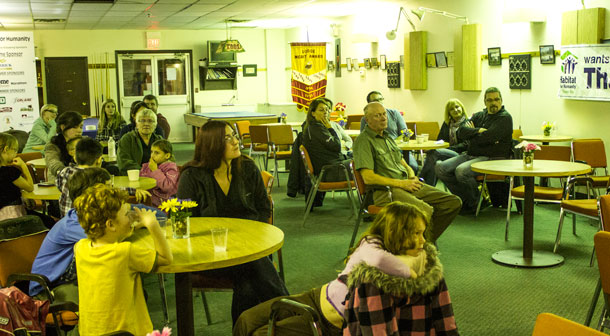
World Habitat Day Celebrated in Canada
MARATHON ON – Monday is World Habitat Day. In Marathon and in Thunder Bay Habitat for Humanity will be hosting two special events. Habitat for Humanity Thunder Bay will celebrate World Habitat Day on October 7th , by holding four home dedications throughout the region. The not-for-profit will generate awareness regarding the need for safe and affordable housing in Thunder Bay while celebrating their successes in the District to date.
Brooklyn and Her Four Part Bucket List
The event is especially exciting for Brooklyn Malley, the young girl has already put her first ‘bucket list’ together. Her first goal is having a house, then going to Catholic School. Then Brooklyn is seeing a family car. Finally the young lady wants an Iphone.
Speaking in Marathon, Sunday night, Diane Mitchell said, “In honour of World Habitat Day tomorrow, we are inviting people in the region to celebrate four families moving into Habitat Homes. I personally am so excited about this achievement and so happy to be here in Marathon to celebrate it”.
Mark Rodgers – COO, Habitat for Humanity Canada speaking in Marathon at the Moose Hall stated, “What I am seeing here today paints the perfect picture of Habitat for Humanity’s mission and vision. Just as all of you have done today, the goal of World Habitat Day is to draw attention to the continuing need for affordable housing and inspire action to address the need”.
“Seeing the amount of support here today from Marathon, and knowing we will be celebrating the dedication of not one, but two, Habitat homes tomorrow, I must say I am inspired,” added Rodgers.
“Tonight we are here to celebrate the people and organizations that helped rebuild these two homes and volunteered their time to provide a safe and happy home to local families in need”.

Across Canada on World Habitat Day there will be 100 Canadians who get into new homes through Habitat for Humanity across the country. There will be 15 homes, with four of those homes being here in Northwestern Ontario.
International Scope For World Habitat Day
“As the number of urban areas increased around the globe, transforming the world’s political, economic and social landscape, it was vital to ensure people’s access to transport and essential basic services”, stated Joan Clos, Executive Director of the United Nations Human Settlements Programme (UN-Habitat”.
In 30 to 40 years, 65 to 70 per cent of the world’s population would live in urban areas, Mr. Clos said, in remarks to commemorate World Habitat Day.
“Urbanization was creating challenges to environmental and economic sustainability and fuelling greenhouse gas emissions”, he said. “Mobility patterns must be changed so that massive transport systems were less dependent on fossil energy. It was equally important to properly finance and guarantee access to transport systems to enable people to reach health services, jobs and education, and to have a sense of community”.
“Mobility was not merely a question of transport systems but also of urban design”, Mr. Clos said. Good urban design required urban spaces that guaranteed mixed use, proximity of services and mobility, and that were resilient in the face of natural disasters. “When we admire a good city, we admire the work of the human society… There is no good city without good human design,” he said.
Joining him at the United Nations Headquarters was Thomas Elmqvist, the scientific editor of Urbanization, Biodiversity and Ecosystem Services: Challenges and Opportunities, which was launched at the press conference. The book, which was produced by the Stockholm Resilience Centre, in collaboration with UN-Habitat, other United Nations agencies and some 200 scientists worldwide, addressed how rapid urbanization affected biodiversity and ecosystems, the first global assessment of its kind.
According to Mr. Elmqvist, it was expected that until 2050 urban areas would grow to about the size of South Africa. Prime agricultural land would significantly be covered by a lot of buildings, straining local infrastructure and posing challenges to local governments. In that regard, investment must be made in those cities in a way that positively impacted health, food and water securities and global resilience.
Asked whether storm Sandy was a result of climate change and global warming, Mr. Clos said that according to the New York Centre of Resiliency, Sandy was very improbable which served as a strong argument that it was indeed triggered by climate change. Both climate change and urbanization, especially in coastal areas, had produced a cumulative increase in the likelihood of such episodes.
Asked about a global designation scheme that identified “great cities”, Mr. Elmqvist said there was none but that regional initiatives did exist, adding that a global designation scheme might be essential to highlight cities in the world that were doing progressive things to address urbanization.
Asked whether UN-Habitat advised Governments, Mr. Clos said the Programme advised central Governments on urban policies, which included resilience, as well as regional and local governments on regional and local planning, respectively. They generally advised Governments to plan city extensions and to allocate at least 35 per cent of land for streets and communications, and 12 per cent to 15 per cent for green areas, riversides and open spaces.
Regarding New York City’s bike-sharing programme and whether the construction of new buildings nearby and a playground near the East River was of concern, Mr. Clos said while UN-Habitat was not involved in local decisions, it did advise “proper compactedness” and “well-designed compactedness”, adding that the bicycle-sharing programme was part of a “fantastic evolution” taking place especially in richer parts of the world. “ New York City has surprisingly given a very positive message regarding a community style of life,” he said.
On how to reconcile the idea of more dense cities with housing costs, Mr. Clos said that the proper balance in density versus sprawl should be well measured and that there existed policies to diminish housing costs, but that such policies depended on political decisions.
Concerning people’s sentiments about adaptation to climate change, Mr. Elmqvist said many people were afraid of the future and looking for guidance and low-cost ways of addressing those issues that did necessarily involve importing important technologies from the West or North, but finding alternative solutions.
On massive urbanization that occurred outside of Governments’ control, he said that, while cities were created by humans, they must not be left to spontaneity. Communities had in the past successfully organized themselves without governmental authority. There could be a very healthy level of collaboration between formal and informal institutions. Such collaboration was crucial in guaranteeing those communities’ resilience.













